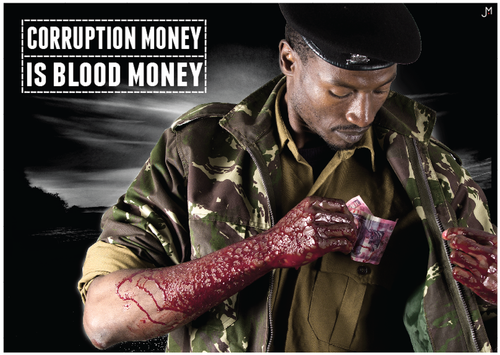Creative Strategies for Human Rights Campaigns-PhotoEx Symposium
CREATIVE STRATEGIES FOR HUMAN RIGHTS CAMPAIGNS
If the photographers, filmmakers, visual artists, activists and advocates who presented their work at PhotoEx are bonded by any one goal, it is the desire to create and inspire change. But in the quest to address complicated and oftentimes painful issues, difficult hurtles arise that compel these dedicated visual storytellers to consider new creative methods.
In the third panel of the PhotoEx symposium, photographer Boniface Mwangi and trans-media artist Thenmozhi Soundararajan presented their projects and explained how they are able to engage and collaborate with the communities they serve to inspire action and raise awareness.
“Coming from a human rights oriented perspective to try to make a difference is very different than coming at things as a documentary photographer with a primary intention to tell the truth,” moderator Gillian Caldwell said to introduce the panel. “How do we think about the differences between the objectivity we expect from our journalistic pursuits and an issue-driven, impact-driven campaign which begins with the premise that we can make a difference?”
Slide from PAWA254 presentation
Mwangi’s photojournalism from Kenya in the post-election violence of 2007 gained him a reputation as ‘the eyes of Kenya,’ and while his photos were published in major newspapers and magazines, he said it wasn’t enough. “I realized I had a bigger responsibility than taking pictures,” he said. “When I took pictures of the post-election violence, I got stuck in that moment, and I realized that people would see the gruesome images I took-but that was it-and that bothered me. I thought that people should do more when they see pictures.”
When the violence in Kenya ended, Mwangi quit his job as a full time photojournalist, and turned the images he made during that tumultuous time into a traveling exhibition, which he hoped would make a more permanent impression on people than an image in a newspaper could. In the process of showing that work, Mwangi came to realize that photography could only say so much, and that other socially minded artists in Kenya had similar goals, and wanted to find a way to bring them all together.
In 2011, Mwangi founded PAWA254, an arts organization that now serves as a creative hub for artists, activists, journalists and young people in Kenya, and is the first organization of it’s kind in Africa. “We are a community of artists, and we have raised issues in the country that have never been raised,” he said. “Our short term goal is awareness. Our long term goal is a political solution.”
Slide from PAWA254 presentation, #DiaperMentality series
In the most extreme cases, artists serve as problem-solvers in communities that have suffered sever human rights violations and have very few, if any, outlets to raise awareness or effect political change. Rooted in one of these communities, Soundararajan is on a crusade to expose the brutality of caste-based sexual violence that women in India are subjected to through her project #Dalitwomenfight. Using a mixture of photography, documentary film making, social media activism, public art projects and grass roots community organizing, Soundararajan said her goal was not to limit herself to a single media, but to use every available resource to address a serious and often fatal political issue.
#Dalitwomenfight presentation
“Fundamentally, I’m here as a storyteller grappling with one of the deepest human rights crises of our time,” she said. “At this point, it wasn’t necessary for me to talk about the medium, because I was going to exploit all mediums to break this story, because the issue is urgent and it must be addressed.”
Soundararajan explained the caste system in India is a means of oppressing people by assigning social labels to them at birth, and that women designated as Dalit, traditionally regarded as untouchable, suffer the most extreme forms of oppression through physical, mental and emotional aggression – to the point where a 2 out of 3 women among a population of 80 million had admitted to being victims of sexual violence. “To end the culture of rape in India, you must end caste,” she said, “and the project #Dalitwomenfight is the opening of that space for that conversation to happen.”
By essentially arming Dalit women with cameras and documenting their interactions with each other, with public officials and with the public-at-large, Soundararajan said her project was empowering an oppressed community, effectively changing the narrative around this horrific and pervasive issue. “We’re beginning to equip activists and survivors with surveillance cameras and other image making machines that they can use so we can take the focus off of Dalit women’s bodies as atrocities, but look at Dalit women as self-determined advocates in their own journey towards justice and use those stories towards getting that justice,” she said.
Slide from #Dalitwomenfight presentation
In human rights and social documentary work, the role of artists and the role of organizer, activist and facilitator are often one in the same. Mwangi and Soundararajan both realized that the stories they wanted to tell required a different level of engagement and responsibility on behalf of the creator and the subjects. When facing issues too big to ignore, they are harnessing the power of technology and grass roots activism to empower and inspire, laying the foundation for significant social and political change to take root.
This is the fourth post in a series that will recap and reconsider the issues and ideas presented at PhotoEx. Our next post will feature highlights from The Future of Editorial panel with Pamela Chen, Gabriel Dance, and Olivia Koski.
Written by Krystal Grow
Krystal Grow is an arts writer, photo editor and producer based in New York. She has written for TIME LightBox, TIME.com, LIFE.com, the New York Times Lens Blog, Stranger Than Fiction, and the DOC NYC blog. Follow her on Twitter and Instagram @kgreyscale.




